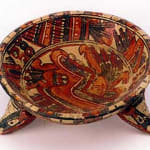Mayan Polychrome Tripod Bowl, 600 CE - 900 CE
Terracotta
PF.2925
By elegantly brushing brilliant hues of reddish brown, orange, black and cream, the Ancient Maya tribe has skillfully painted one of the various Maya zoomorphic creatures. The overall forms of...
By elegantly brushing brilliant hues of reddish brown, orange, black and cream, the Ancient Maya tribe has skillfully painted one of the various Maya zoomorphic creatures. The overall forms of Maya zoomorphic creatures may derive from a particular animal, such as the serpent depicted on this plate. As we can see, though, they are never mistaken for creatures of the natural world because their features combine with those of several animals. The serpent depicted here has merged with jaguar and bird features. Its mouth does not hiss, but lets out an almighty roar of the ferocious jaguar. The serpent's head and chin have been crowned with dazzling feathers of the noble Maya tropical bird: the quetzal. These important symbolic features combine to indicate the sacred context of this rich endowed zoomorphic serpent. In Maya cosmology, zoomorphic creatures are usually mediators between the supernatural world and the human world who manifest both cause and effect in these two separate worlds. This plate was most probably manufactured for a Maya lord to use in rituals. The Maya believed that inanimate objects accrued potency through usage in rituals. This accumulated power became so intense and dangerous that, in order to release it, the Maya regularly "killed" buildings by removing faces of sculptures depicting both humans and zoomorphic creatures and drilling holes in pottery. Beyond the penetrating gaze and commanding presence of this zoomorphic serpent, past the band of alternating motifs encircling the rim, and behind the fierce snarls of the jaguar tripod "feet," we may not be surprised to see the drilled holes in this plate revealing to us its past significant role in ritual and its subsequent fate.



